So its been a few weeks since I posted anything, so I thought I'd do something a bit different this time and take you into my real passion. If you like dogs or plan to be around them then try this blog out, you may learn something. If not, it will at least be interesting.
As part of our animal behavior class my teacher showed us this video with the request that we ignore the narrator and watch the dog. I want you to essentially do the same thing and see if you are at all surprised by the outcome. Watch the entire video before moving on in the blog.http://www.youtube.com/watch?v=PHLnjiISsOoSo, surprised? I doubt it. What signs did you see that warned of the outcome? Who is to blame? Try writing these down and see if I add anything or change any of your first impressions.
First I'll take you through what Pedro is saying: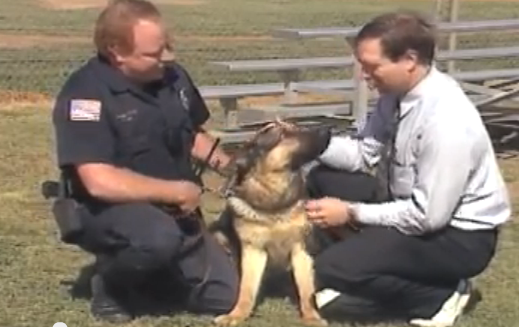 The first and probably the most alarming thing to notice is the direction of Pedro's gaze. Submissive, frightened dogs look any direction but at what is scaring them. However, fear aggressive dogs keep their eyes on the threat at all times so they can be ready to defend themselves. Pedro is basically saying 'you are making me uncomfortable and I will defend myself.'Second, look at the slight angle of Pedro's body. He is pinned in-between the two men but is leaning away from the reporter; another sign that the reporter is making him uncomfortable.Now look at this one:
The first and probably the most alarming thing to notice is the direction of Pedro's gaze. Submissive, frightened dogs look any direction but at what is scaring them. However, fear aggressive dogs keep their eyes on the threat at all times so they can be ready to defend themselves. Pedro is basically saying 'you are making me uncomfortable and I will defend myself.'Second, look at the slight angle of Pedro's body. He is pinned in-between the two men but is leaning away from the reporter; another sign that the reporter is making him uncomfortable.Now look at this one: Sorry the image isn't that great, but hopefully you can see Pedro's tongue. Here he is licking his nose. This is not a sign of submission, as most people think. It is meant to be reassuring to the aggressor, saying 'look I'm not showing my teeth yet, but I don't like what you are doing.' Also notice Pedro's eyes and ears. You can see the whites of his eyes, a sign of dress in all dogs (with the exception of those with bulging eyes). His ears are back as far as he can lay them; another sign that the reporter is upsetting him.
Sorry the image isn't that great, but hopefully you can see Pedro's tongue. Here he is licking his nose. This is not a sign of submission, as most people think. It is meant to be reassuring to the aggressor, saying 'look I'm not showing my teeth yet, but I don't like what you are doing.' Also notice Pedro's eyes and ears. You can see the whites of his eyes, a sign of dress in all dogs (with the exception of those with bulging eyes). His ears are back as far as he can lay them; another sign that the reporter is upsetting him. 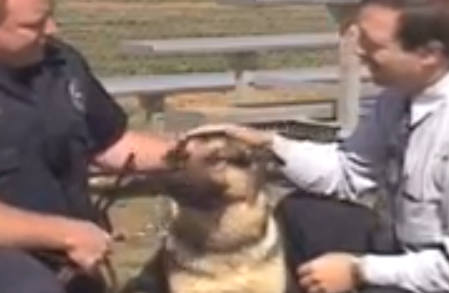 Now to understand this one you need to know a bit about police dog training. They are trained to be the 'second in command' as the officer put it. This means they look to their alpha, the officers, for direction before acting. However, being seen as the alpha requires that the dog knows and respects you. Now, back to Pedro, at the beginning it is mentioned that the partnership between him and his officer is new and that the officer 'does not know his personality,' in other words, he has not yet spent enough time with Pedro to gain his respect and the position of alpha.In that picture Pedro is glancing at the officer, looking for direction and getting nothing and without confidence in the officer he has to make a decision for himself.As my teacher put it, Pedro is "Doing everything he can to say 'leave me alone or I'm going to bite you' except hold up a sign, which he can't do because he doesn't have thumbs."
Now to understand this one you need to know a bit about police dog training. They are trained to be the 'second in command' as the officer put it. This means they look to their alpha, the officers, for direction before acting. However, being seen as the alpha requires that the dog knows and respects you. Now, back to Pedro, at the beginning it is mentioned that the partnership between him and his officer is new and that the officer 'does not know his personality,' in other words, he has not yet spent enough time with Pedro to gain his respect and the position of alpha.In that picture Pedro is glancing at the officer, looking for direction and getting nothing and without confidence in the officer he has to make a decision for himself.As my teacher put it, Pedro is "Doing everything he can to say 'leave me alone or I'm going to bite you' except hold up a sign, which he can't do because he doesn't have thumbs."
Now let's look at what the men are doing: First I'll show this picture again to get the general layout: Once again, we need to think about what Pedro's job is. What do Police dogs do? They protect their officer. So when they are doing their job, where are they located? Between their officer and the perpetrators, exactly where Pedro is. Compare the body positioning of the two men as well. Notice the officer positioned his body straight and upright. The reporter, on the other hand, is leaning forward, almost on top of Pedro. What the officer said is true, towering or leaning over is a sign of dominance in the dog world.
Once again, we need to think about what Pedro's job is. What do Police dogs do? They protect their officer. So when they are doing their job, where are they located? Between their officer and the perpetrators, exactly where Pedro is. Compare the body positioning of the two men as well. Notice the officer positioned his body straight and upright. The reporter, on the other hand, is leaning forward, almost on top of Pedro. What the officer said is true, towering or leaning over is a sign of dominance in the dog world. 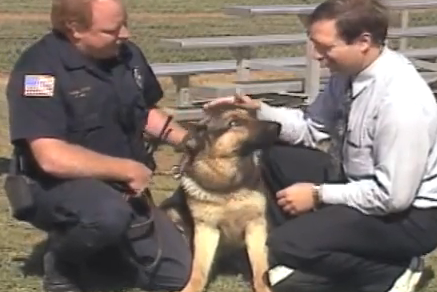 Check out the reporter's hand. Is he really patting the dog on the head? Dogs love to be stroked and scratched around the head, but patting is just being hit on the head. I mean, do you like getting patted on the head? So what does the genius do next:
Check out the reporter's hand. Is he really patting the dog on the head? Dogs love to be stroked and scratched around the head, but patting is just being hit on the head. I mean, do you like getting patted on the head? So what does the genius do next: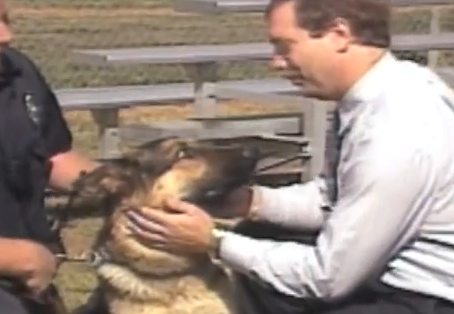 Why would you ever put your hands, even loosely, around a strange dog's neck?Notice Pedro still hasn't bitten the man, its not until:
Why would you ever put your hands, even loosely, around a strange dog's neck?Notice Pedro still hasn't bitten the man, its not until: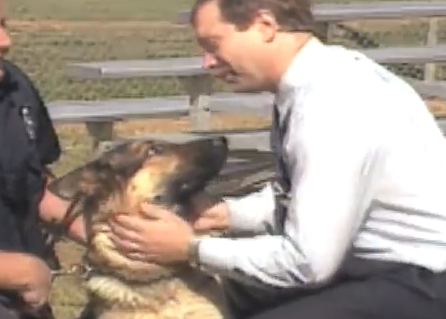 Yep, the man leans over him even more.
Yep, the man leans over him even more.
Honestly, I don't blame Pedro, if a strange man sat against me, leaned in, patted my head, put his hands around my throat, and then tried to lean in even closer, I would have punched him in the face too (actually I would have probably done more damage and it would have started at the sitting against me part). And really 'punch' is all Pedro did, only he doesn't have fists, just his mouth: 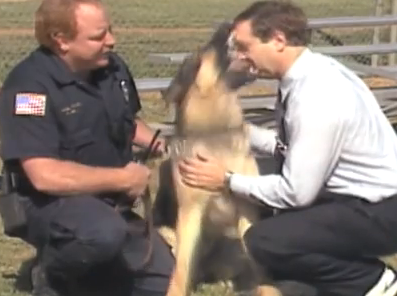 Notice Pedro is not actually trying to latch onto any part of the man. Despite what the narrator said, police dogs are thought to bite down and not let go rather than just rake their teeth across people. This was just another, more serious, way to say 'back off.' If Pedro was actually trying to do some damage all he would have had to do was latch on to that lovely neck a foot from his face or grab one of the arms.So, do you blame the dog? I hope not.The reporter? That's closer, but sadly he's just a man who can't read dog body language and lacks common sense.There was one man there that should have known though; the officer. It is his job to know and understand his dog. Not once did he try to calm Pedro or reassure him. Frankly he was too busy with the camera to relay pay attention to his dog. In fact all of this could have been avoided if the reporter had been introduced to and taught how to handle Pedro before the cameras started rolling. Before you worry, Pedro was fine. Police dogs are exempt from the dog bite policy.
Notice Pedro is not actually trying to latch onto any part of the man. Despite what the narrator said, police dogs are thought to bite down and not let go rather than just rake their teeth across people. This was just another, more serious, way to say 'back off.' If Pedro was actually trying to do some damage all he would have had to do was latch on to that lovely neck a foot from his face or grab one of the arms.So, do you blame the dog? I hope not.The reporter? That's closer, but sadly he's just a man who can't read dog body language and lacks common sense.There was one man there that should have known though; the officer. It is his job to know and understand his dog. Not once did he try to calm Pedro or reassure him. Frankly he was too busy with the camera to relay pay attention to his dog. In fact all of this could have been avoided if the reporter had been introduced to and taught how to handle Pedro before the cameras started rolling. Before you worry, Pedro was fine. Police dogs are exempt from the dog bite policy.
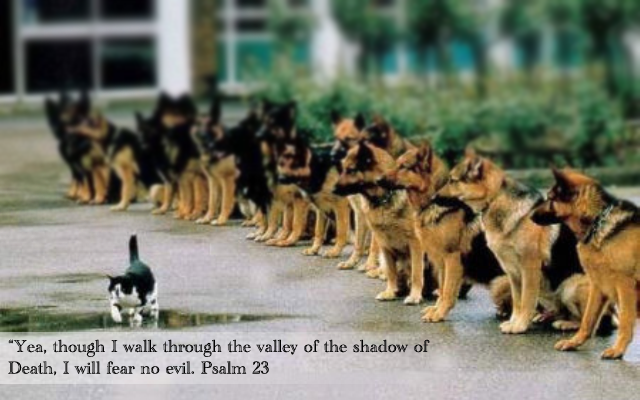
First of all, the style of American "documentary" programs is apparently going through puberty right now. SLOMO 3D FUCKING ATTACK! LET'S SEE THAT AGAIN FOUR FUCKING TIMES!
Second of all, I'm not a big fan of "dog psychology" as it is generally peddled, probably because of trauma caused by my mother's obsession with Cesar Millan, but also every trainer gets their own unique ideas on the subject (that being said, thanks for posting this, I'll get paranoid about observing dogs now).21st century ethologists generally cringe at notions such as "alpha" (canine packs correspond to kinship groups, so "alpha" basically translates into "father" or "oldest sibling" in nature). This doesn't particularly change what you posted, I'm just saying :pActually alpha is a personality type in dogs. Alpha is leader and thus why humans need this position to work with their dog. I'm actually in school for this stuff so I tend to trust my teacher an RVT, over anything people say out of practice.
None of this is 'dog psychology' but merely reading the body language. This is just the basics so what I said here is very reliable. We aren't reading their minds, just the language they use to communicate with each other. That's the point of animal behavior.I'm an expert at reading Dog body language.
My advice?Stay the fuck away from other people's Monday to Friday Dogs, you Monkey Fighters.Now I want to point out the gammas-omegas are not necessarily ordered one above the other, they just represent the other personality types.
It's the cop's fault, because he should know his dog. The dog kept trying to pull away, he was putting his ears back. Then the idiot grabbed his face with both hands as he loomed over his face. What an idiot.
I muted the video so I could just watch the dog and the dog reacted reasonably.